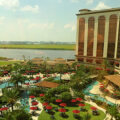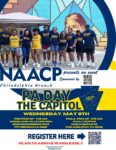By Renée S. Gordon
Let me begin by saying that there is no “short” tour of Savannah. This is a city with a unique aura that must be experienced and savored. Each of its numerous squares creates an enclave of culture and history and as you meander through them you are encased in a capsule of times past.
On February 22, 1733 the ship Anne bearing 114 colonists and James Edward Oglethorpe landed on Yamacraw Bluff on the Savannah River. This English colony, the last of the original 13, was planned as an idyllic settlement where slavery, alcohol and Catholics were banned. The town, one of the first planned cities in the country, was formed to help the English poor, establish “plantations” to plant crops and to serve as a military buffer between English and Spanish territories. Savannah was designed with 24 squares, 21 of which remain, and a series of trust lots.
The ease of settlement was largely due to two Native Americans, Coosaponakeesa (Mary Musgrove), a biracial Creek Indian who served as a liaison and translator, and the Yamacraw Chief Tomochichi who granted them permission to live there. Tomochichi’s contribution to the city’s founding was so great that on the 60th anniversary of his death a granite boulder from Stone Mountain was placed on his gravesite in Wright Square.
Slavery was introduced into the colony even before the ban was lifted in 1750. Colonists found that slaves were easily obtained from other colonies and records indicate that illegal sales were held on the waterfront. Immediately prior to 1776 there were 15,000 slaves held in the territory and sales were held legally in the City Market.
There is so much history in Savannah that a guided orientation tour is necessary and Old Town Trolley Tours is just the ticket. Historic tours are scheduled every 20-minutes and include 20 stops and free parking. Visitors can opt for specialized tours such as the Paula Deen, Girl Scout Discover Savannah or Ghosts and Gravestones. www.trolleytours.com/savannah
The best view of the city is obtained as you enter via the cable-stayed Talmage Memorial Bridge spanning the Savannah River. You can catch glimpses of many of the most important structures in the 2.5-sq.mi. National Landmark District bounded by the Savannah River, East Broad Street, Gwinnett Street, and Martin Luther King, Jr. Boulevard. The Savannah College of Art and Design (SCAD) can be credited with the salvation and maintenance of many of the historic properties. The inner-city campus has only three new buildings all of the others are restored existing structures.
The 270-year old Candler Oak Tree was granted Georgia Landmark status in 2001. The 5-acres around the tree has functioned as the site of both Union and Confederate hospitals and a poor house. This stately tree stands 54-ft. tall and nearly 17-ft. in circumference. Drayton and Gaston Sts.
Forty-two Jews who landed in Savannah in July of 1773 founded Temple Mikve Israel in Monterey Square in 1876. It is the oldest Jewish congregation in the South and the only Gothic synagogue in the US erected. Showcased within the synagogue is a deerskin Torah, the oldest in the country. www.mickveisrael.org
A three story brick bank built by black contractor Robert Pharrow serves as the Ralph Gilbert Civil Rights Museum, 460 MLK Blvd. The museum is named in honor of a civil rights activist and interprets the history of the movement through interactive exhibits, photographs and documents. www.savcivilrights.com
The King-Tisdell Cottage is a restored 1896 Victorian house with outstanding architectural elements such as graceful gingerbread ornamentation on the exterior. The first black residents purchased the home in 1910. Currently the cottage functions as a repository for the African American legacy of the city and the Sea Islands through documents and photographs. 514 E. Huntingdon St. www.kingtisdell.org/beachinst
One year after the end of the Civil War the Freedman’s Bureau built Beach Institute to educate freedmen and staffed it with white northerners from the American Missionary Association staffed it. In 1875, it was turned over to the Savannah Board of Education and it became a free public school for black children. It closed in 1919 and eventually reopened as a cultural center. Afro centric programming and scheduled events are augmented by the premier collection of Ulysses Davis’ woodcarvings. It is the oldest surviving educational institute in GA. 502 E. Harris Street.
First African Baptist Church, 23 Montgomery St., is an important site on the African American History Trail. George Liele, a slave of a British officer, was freed because of his ability to preach and in 1773 he founded a congregation on the Brampton Plantation deemed the Ethiopian Church of Jesus Christ. He was ordained a minister in 1775 and in 1782 when the British evacuated Savannah he left for Jamaica with them. His missionary work was taken over by an ex-slave, Andrew Bryan, he had baptized in 1781. By the 1790s Bryan had raised enough money to purchase land and build a wooden structure. The current neoclassical brick church was constructed in 1859 and is the oldest brick building in the state. Slaves and freedmen working after their regular day’s work built it. Some of the original pews are in the basement and still bear tribal markings. Oral history states that the church was a stop on the Underground Railroad and diamond shaped holes in the floor were used to allow fugitives to get air. www.theoldestblackchurch.org
Second African Baptist Church, 123 Houston St., was founded in 1802 and the 67-ft. by 30-ft. Second Colored Baptist Church was completed on its current site by December of the same year. Legend has it that slaves were clandestinely taught to read in the basement with the sound muffled by the four foot thick walls.
General Sherman stood on the church steps to read the Emancipation Proclamation and to announce the infamous “40-acres and a mule,” Special Field Order #15. This was also the site of Martin Luther King, Jr’s first oral presentation of his “I Have a Dream” speech. www.secondafrican.org
When General Sherman occupied the city he headquartered in the 1853 Green-Meldrum House on Madison Square. On January 12, 1865 he and Edwin Stanton met with a group of 20 black leaders to discuss what they believed would best benefit the newly emancipated. It was here that Special Field Order 15 was drafted. It gave freedmen land grants of no more than 40-acres along a 30-mile stretch of coastline from South Carolina to Georgia. The order was later rescinded by Lincoln’s successor.
The 1819 Owen Thomas House, one of the finest examples of English Regency architecture in the country, is located at 124 Abercorn St. Of particular note are the intact slave quarters with original furniture and “haint blue” painted walls. Slaves believed that spirits were repelled by the color. Note that many other homes in Savannah have touches of the color around sills and doors.
In 1852 the city designated 15-acres in Laurel Grove South Cemetery for the exclusive use of mulattoes and freed and enslaved blacks. The cemetery reveals the names of both notable members of the black community and the identities of those who might otherwise be forgotten.
Maya Angelou penned the inscription on the bronze and granite African American Families Monument in Rousakis Plaza. Dedicated in 2002, it is the first sculpture created to honor African Americans in the city. There are several sites that every tourist visits and they are both connected with books and movies. Chippewa Square is where Forrest Gump sits for 80 percent of the movie, tells his life story and compares life to a box of chocolates. The actual bench used in the movie is on display in the Savannah History Museum.
“Midnight in the Garden of Good and Evil” captured the essence of Savannah and one can visit sites connected with it throughout the historic district. The Mercer House, 429 Bull St., was the mansion in which the crime took place. Tours are offered of the main floor. www.mercerhouse.com
Club One, Bay and Jefferson Sts., is where Lady Chablis got her start and continues to perform several times a month. A walk along Savannah’s River Street and a photo with the iconic Waving Girl Statue is a must. The walk is filled with eclectic shops and trendy restaurants and it is a great place to purchase souvenirs. The Savannah Theater provides a unique evening experience. The 1818 building has been restored to 1940s Art Deco elegance and the performances are thoroughly entertaining and family friendly. 222 Bull St. www.savannahtheatre.com
Four Points By Sheraton Historic Savannah, 520 W. Bryan St., is located in the heart of the historic district near sites on the African American History Trail. Amenities include pool, fitness center, restaurant, handicap accessible rooms and a tantalizing variety of special packages. www.fourpointssavannahhotels.com
The Downtown Savannah Country Inn & Suites Hotel is walking distance to most of the historic attractions and the district’s complimentary shuttle picks up at the front door. The amenities include complimentary breakfast buffet and concierge service. This hotel has initiated a special program of dedicating suites to individuals from the city that have made outstanding contributions. The first of such dedications honors Dr. Amelia Platts Boynton-Robinson considered one of the founders of the civil rights movement and at 99-years old is the oldest living graduate of Tuskegee Institute. Guests can request this suite. www.countryinns.com/Savannah
The Inn at Ellis Square is considered the “Grand Lady of Bay Street.” Winner of Savannah’s Historic Preservation Award, the inn manages to both maintain its historic ambience and provide superb service and amenities. Through an innovative recycling program the hotel impacts the lives of individuals at the national and international level. 201 W. Bay St. www.innatellissquare.com Savannah is a jewel beyond price but we can afford to visit. Information is available online. www.savannahvisit.com
I wish you smooth and informative travels!
















Leave a Comment